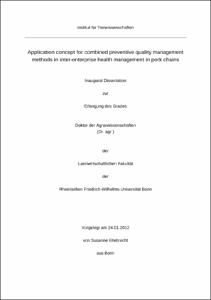Ellebrecht, Susanne: Application concept for combined preventive quality management methods in inter-enterprise health management in pork chains. - Bonn, 2012. - Dissertation, Rheinische Friedrich-Wilhelms-Universität Bonn.
Online-Ausgabe in bonndoc: https://nbn-resolving.org/urn:nbn:de:hbz:5n-28024
Online-Ausgabe in bonndoc: https://nbn-resolving.org/urn:nbn:de:hbz:5n-28024
@phdthesis{handle:20.500.11811/5099,
urn: https://nbn-resolving.org/urn:nbn:de:hbz:5n-28024,
author = {{Susanne Ellebrecht}},
title = {Application concept for combined preventive quality management methods in inter-enterprise health management in pork chains},
school = {Rheinische Friedrich-Wilhelms-Universität Bonn},
year = 2012,
month = apr,
note = {Overall, this thesis aimed at establishing a concept to organize and evaluate services in inter-enterprise health and quality management with the help of team-oriented preventive quality management methods in a new and more efficient form. In this context, the question was addressed to which extent existing service offers still meet the actual customer expectations of farmers. Furthermore, it was of interest to find out which quality management methods are already known to the service providers of the sector and are integrated into their teamwork. Answering these research questions was a precondition for assessing the development potentials of future service offers and service organizations in inter-enterprise health management.
This methodology to develop an application concept for team-oriented quality management methods for such service providers was subdivided into six different phases.
While the first three phases (literature study, written enquiry (206) and 55 expert interviews) covered data collection, in phase four a proposal was made how to proceed with the expansion of network coordinators’ service portfolios. When doing this, the categorization of products and services used by Kano served as a basis. Phase five included development of an application concept with preventive quality management methods. Subdivision of quality management methods into the relevant partial steps and merging these into a methodology enabled allowing for characteristics belonging to selected methods combined into one concept. The final phase 6 included development of a structural equation model on the basis of the established findings visualizing causal relations between defined factors and the quality of coordination services. This model included seven latent variables, 16 formative and three reflective indicators.
In a diagram consisting of four quadrants (“QM+CS Stars”, “CS Freeloader”, “QM Question Marks” and “QM+CS Dogs”), it was possible to subdivide the network coordinators questioned into three clusters regarding the offer of services in inter-enterprise health management (CS) and the use of quality management methods. The compiled application concept for quality management methods supports development of network coordinators regarding the use of quality management methods towards “QM+CS Stars” by integrating partial steps of quality management methods into the normal operations of enterprises. In contrast to this, the modified Kano categorization enables to optimally consider customer expectations when expanding service portfolios. For example, services not demanded directly by farmers but which provide them with an enormous added value are classified as “attractive services”. In addition to this, the causal relations demonstrated in the structural equation model regarding the quality of coordination services serve to increase the quality of existing and new services and thus to optimally satisfy customer expectations.},
url = {https://hdl.handle.net/20.500.11811/5099}
}
urn: https://nbn-resolving.org/urn:nbn:de:hbz:5n-28024,
author = {{Susanne Ellebrecht}},
title = {Application concept for combined preventive quality management methods in inter-enterprise health management in pork chains},
school = {Rheinische Friedrich-Wilhelms-Universität Bonn},
year = 2012,
month = apr,
note = {Overall, this thesis aimed at establishing a concept to organize and evaluate services in inter-enterprise health and quality management with the help of team-oriented preventive quality management methods in a new and more efficient form. In this context, the question was addressed to which extent existing service offers still meet the actual customer expectations of farmers. Furthermore, it was of interest to find out which quality management methods are already known to the service providers of the sector and are integrated into their teamwork. Answering these research questions was a precondition for assessing the development potentials of future service offers and service organizations in inter-enterprise health management.
This methodology to develop an application concept for team-oriented quality management methods for such service providers was subdivided into six different phases.
While the first three phases (literature study, written enquiry (206) and 55 expert interviews) covered data collection, in phase four a proposal was made how to proceed with the expansion of network coordinators’ service portfolios. When doing this, the categorization of products and services used by Kano served as a basis. Phase five included development of an application concept with preventive quality management methods. Subdivision of quality management methods into the relevant partial steps and merging these into a methodology enabled allowing for characteristics belonging to selected methods combined into one concept. The final phase 6 included development of a structural equation model on the basis of the established findings visualizing causal relations between defined factors and the quality of coordination services. This model included seven latent variables, 16 formative and three reflective indicators.
In a diagram consisting of four quadrants (“QM+CS Stars”, “CS Freeloader”, “QM Question Marks” and “QM+CS Dogs”), it was possible to subdivide the network coordinators questioned into three clusters regarding the offer of services in inter-enterprise health management (CS) and the use of quality management methods. The compiled application concept for quality management methods supports development of network coordinators regarding the use of quality management methods towards “QM+CS Stars” by integrating partial steps of quality management methods into the normal operations of enterprises. In contrast to this, the modified Kano categorization enables to optimally consider customer expectations when expanding service portfolios. For example, services not demanded directly by farmers but which provide them with an enormous added value are classified as “attractive services”. In addition to this, the causal relations demonstrated in the structural equation model regarding the quality of coordination services serve to increase the quality of existing and new services and thus to optimally satisfy customer expectations.},
url = {https://hdl.handle.net/20.500.11811/5099}
}






